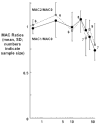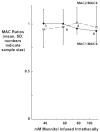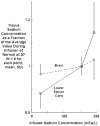Increases in spinal cerebrospinal fluid potassium concentration do not increase isoflurane minimum alveolar concentration in rats
- PMID: 18713900
- PMCID: PMC2693418
- DOI: 10.1213/ane.0b013e3181815f2b
Increases in spinal cerebrospinal fluid potassium concentration do not increase isoflurane minimum alveolar concentration in rats
Abstract
Background: Previous studies demonstrated that MAC for isoflurane directly correlates with the concentration of Na(+) in cerebrospinal fluid surrounding the spinal cord, the primary site for mediation of the immobility produced by inhaled anesthetics. If this correlation resulted from increased irritability of the cord, then infusion of increased concentrations of potassium (K(+)) might be predicted to act similarly. However, an absence of effect of K(+) might be interpreted to indicate that K(+) channels do not mediate the immobility produced by inhaled anesthetics whereas Na(+) channels remain as potential mediators. Accordingly, in the present study, we examined the effect of altering intrathecal concentrations of K(+) on MAC.
Methods: In rats prepared with chronic indwelling intrathecal catheters, we infused solutions deficient in K(+) and with an excess of K(+) into the lumbar space and measured MAC for isoflurane 24 h before, during, and 24 h after infusion. Rats similarly prepared were tested for the effect of altered osmolarity on MAC (accomplished by infusion of mannitol) and for the penetration of Na(+) into the cord.
Results: MAC of isoflurane never significantly increased with increasing concentrations of K(+) infused intrathecally. At infused concentrations exceeding 12 times the normal concentration of KCl, i.e., 29 mEq/L, rats moved spontaneously at isoflurane concentrations just below, and sometimes at MAC, but the average MAC in these rats did not exceed their control MAC. At the largest infused concentration (58.1 mEq/L), MAC significantly decreased and did not subsequently return to normal (i.e., such large concentrations produced injury). Infusions of lower concentrations of K(+) had no effect on MAC. Infusion of osmotically equivalent solutions of mannitol did not affect MAC. Na(+) infused intrathecally measurably penetrated the spinal cord.
Conclusions: The results do not support a mediation or modulation of MAC by K(+) channels.
Figures




Similar articles
-
Alterations in spinal, but not cerebral, cerebrospinal fluid Na+ concentrations affect the isoflurane minimum alveolar concentration in rats.Anesth Analg. 2007 Sep;105(3):661-5. doi: 10.1213/01.ane.0000278090.88402.26. Anesth Analg. 2007. PMID: 17717220
-
Glycine receptors mediate part of the immobility produced by inhaled anesthetics.Anesth Analg. 2003 Jan;96(1):97-101, table of contents. doi: 10.1097/00000539-200301000-00021. Anesth Analg. 2003. PMID: 12505932
-
Thiopental produces immobility primarily by supraspinal actions in rats.Anesth Analg. 2005 Jan;100(1):128-136. doi: 10.1213/01.ANE.0000139353.97950.FA. Anesth Analg. 2005. PMID: 15616066
-
Insulin decreases isoflurane minimum alveolar anesthetic concentration in rats independently of an effect on the spinal cord.Anesth Analg. 2004 Jun;98(6):1712-1717. doi: 10.1213/01.ANE.0000113550.47942.47. Anesth Analg. 2004. PMID: 15155333
-
Inhaled anesthetics and immobility: mechanisms, mysteries, and minimum alveolar anesthetic concentration.Anesth Analg. 2003 Sep;97(3):718-740. doi: 10.1213/01.ANE.0000081063.76651.33. Anesth Analg. 2003. PMID: 12933393 Review.
Cited by
-
Is a new paradigm needed to explain how inhaled anesthetics produce immobility?Anesth Analg. 2008 Sep;107(3):832-48. doi: 10.1213/ane.0b013e318182aedb. Anesth Analg. 2008. PMID: 18713892 Free PMC article. Review.
References
-
- Yost CS. Tandem pore domain K channels: an important site of volatile anesthetic action? Curr Drug Targets. 2000;1:207–17. - PubMed
-
- Franks NP, Lieb WR. Volatile general anaesthetics activate a novel neuronal K+ current. Nature. 1988;333:662–4. - PubMed
-
- Franks NP, Lieb WR. Stereospecific effects of inhalational general anesthetic optical isomers on nerve ion channels. Science. 1991;254:427–30. - PubMed
-
- Patel AJ, Honore E, Lesage F, Fink M, Romey G, Lazdunski M. Inhalational anesthetics activate two-pore-domain background K+ channels. Nat Neurosci. 1999;2:422–6. - PubMed
-
- Tanifuji Y, Eger EI., II Brain sodium, potassium, and osmolality: Effects on anesthetic requirement. Anesth Analg. 1978;57:404–10. - PubMed
Publication types
MeSH terms
Substances
Grants and funding
LinkOut - more resources
Full Text Sources

